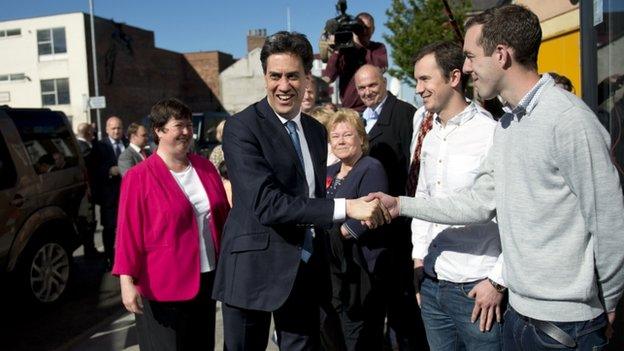Reality Check: Rent controls and costs
- Published

Labour has announced it would guarantee three-year tenancy agreements with rent increases "capped" at the rate of inflation for those renting in the private sector in England.
The party hopes that this will help the 4.4m households (19%) renting privately. According to the English Housing Survey (EHS) the sector that has doubled in size since 2002. This is particularly among the young, labelled "Generation Rent".
In 2013-14, 48% of all households aged 25-34 rented privately. That's more than double the proportion in 2003-4 (21%). This is matched by a decreasing number of younger homeowners. In 1991, 67% of that age group were homeowners. By 2011/12, this had declined to 43%, according to the Office for National Statistics (ONS).
We also know that private renters move more frequently. In 2013-14, 35% of private renters had been in their home for less than a year, and 67% for less than three years. We don't know how often this is out of choice, for example due to the nature of their work, or in search of cheaper rents.
The English Housing Survey also indicated that the longer private renters had been in their home, the less rent they paid. As demand outstrips supply in the rental market, new tenants are being charged higher rents than people who have been in the same property for years.
Labour hopes landlords will also see a benefit to three-year tenancies - that, for example, tenants might be more likely to care for a property if they know they'll be living there longer. Critics say rent controls will lead to substandard housing. They also say it might raise rents in the short term, with landlords putting up prices at the start of a lease.
Some history
It wouldn't be the first time that there have been rent controls in England. In 1915 the UK government imposed limits on the initial rent landlords could charge as well as any subsequent rises. According to the House of Commons library, at that time private rented housing made up about 90% of the housing stock.
While this was supposed to be a temporary measure, it was repeatedly extended because of the continued housing shortage. Rental control for new lets only ended in 1989. By 1991 the private rented sector declined to 7% of the market.
Rental prices
In 2013-14, average weekly private rents were £281 in London and £145 outside of London, according to the EHS. The Office for National Statistics (ONS) publishes an Index of Private Housing Rental Prices (IPHRP), which measures the change in price of renting from private landlords. It's important to note that the ONS says the IPHRP is a new "experimental statistic". Since January 2012, annual English rental price increases have ranged from 1.4% to 3% year-on-year, with March 2015 prices 2.1% higher than a year earlier. Excluding London, English rental prices increased 1.5% for the same period.
The ONS publishes information on rent increases going back to 2006. Annual rent increases were at their highest in 2008, but rents actually fell during 2010, before rising again from 2011. If you exclude London, rents have increased less than inflation for almost all the period since 2008 until very recently, when inflation has been very low. Private renters spend proportionally more of their income on housing costs than mortgagors, although private renters tend to earn less.
On average, owner occupiers buying with a mortgage spent 20% of their income on their mortgage whilst private renters spent 40%, according to the 2012/13 English Housing Survey.

Election 2015 - Reality Check

What is the truth behind the politicians' claims on the campaign trail? Our experts investigate the facts, and wider stories, behind the soundbites.
Read latest updates or follow us on Twitter @BBCRealityCheck, external

- Published27 April 2015
